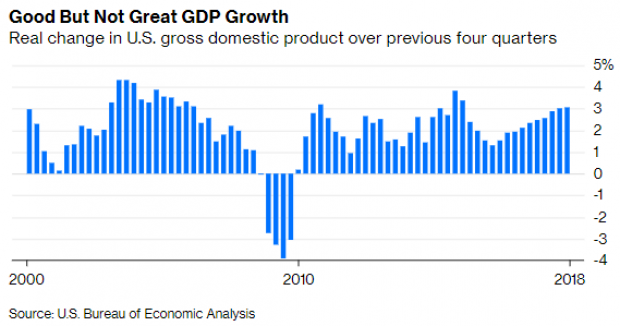Economic growth in 2018 was stronger than it has been since 2015, but whether it was it was strong enough for supporters of the $1.5 trillion Republican tax cut remains an open question.
According to an initial estimate released by the Bureau of Economic Analysis Thursday, the economy grew at a 2.6 percent annualized rate in the fourth quarter, bringing the annual growth rate for 2018 to 2.9 percent – just shy of the Trump administration’s goal of 3 percent or better.
Where the economy stands today: Overall, growth in the fourth quarter was a bit stronger than many economists expected. While the data indicates that the economy slowed in the final quarter of the year from the 3.4 percent growth rate recorded in the third quarter, the initial estimate of 2.6 percent annualized growth is higher than the 2.2 percent predicted by analysts.
“Last year was likely the best year of this business cycle. We stimulated the heck out of the economy last year and that stimulus will fade this year,” said Morgan Stanley’s Ellen Zentner.
Where the economy is headed: Like Zentner, most economists expect growth to slow significantly in the coming quarters, due in large part to the fading effects of the tax cuts and the two-year spending deal that goosed federal outlays in 2018 and 2019. “As the stimulus fades and the lagged impact of past monetary tightening continues to feed through, we expect GDP growth to slow to 2.2% this year and only 1.2% in 2020,” said Capital Economics’ Paul Ashworth.
Jason Furman, who served as President Obama's chairman of the Council of Economic Advisers and is now a professor at the Harvard, tweeted: “Given the large amount of fiscal stimulus in 2018 is unlikely to be repeated and the labor market has less room than it did a year ago, is very likely this is a high water mark for the recent period. Growth in 2019 is tracking around 1% and potential growth is around 1.75%.
The White House sticks to its guns: The 3 percent annual growth figure is an important part of the Trump economic plan and has been cited many times by various members of the administration. "The foundation for the plan is 3 percent growth. In fact, that IS Trumponomics," then-budget director Mick Mulvaney told Congress in 2017.
On Thursday, Kevin Hassett, head of President Trump’s Council of Economic Advisors, cited an alternate measure of growth, based on a four-quarter average rather than the more complex calculation used by the BEA, that shows the economy growing at a 3.1 percent rate in 2018 – meeting the administrator’s 3 percent goal, though still well short of the 4 percent (and higher) sometimes promised by Trump.
“Our policies are working,” Hassett said. “We said there would be a capital spending boom and we would get 3.1 percent growth. That is what happened." And Hassett predicts the trend will continue, with growth rising to 3.2 percent in 2019 — a very different forecast than other mainstream economists.
A return to the post-recession trend? Bloomberg’s Justin Fox argued that if you use Hassett’s four-quarter average method to calculate GDP growth, then the economy’s performance in 2018 is less impressive than it first appears and is roughly in line with the trend that began in the wake of the recession nearly a decade ago (see the chart below).
Here’s how Fox summed up his view on the current state of economic growth:
“As far as growth goes, then, the Trump Economy is looking quite a lot like the Obama Economy. Growth this deep into an expansion is in a way more significant, since lower unemployment rates mean that more people get to share in it and have started to boost wages in a big way. So it’s not crazy that consumer confidence has been higher over the past couple of years than it had been since 2000. The economic conditions really have been quite good. But the frequently made claim that the Trump administration has delivered some kind of economic sea change isn’t backed up by the GDP numbers.”





